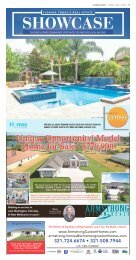Space Coast Parent - January 2018
2018: Eating Clean in the new year, Space Coast WHAT’S HAPPENING Calendar filled with tons of fun, STAYING HEALTHY IN THE WINTER - How to keep the germs away, SCIENCE EXPERIMENT - Bringing the lessons home
2018: Eating Clean in the new year, Space Coast WHAT’S HAPPENING Calendar filled with tons of fun, STAYING HEALTHY IN THE WINTER - How to keep the germs away, SCIENCE EXPERIMENT - Bringing the lessons home
You also want an ePaper? Increase the reach of your titles
YUMPU automatically turns print PDFs into web optimized ePapers that Google loves.
Science Fun at Home<br />
MICHELLE BERRY<br />
After teaching for 14 years, I still<br />
enjoy finding fun, creative ways to<br />
inspire my students and help them<br />
develop a love for learning.<br />
<strong>Parent</strong>s can easily encourage their<br />
children and continue to foster the<br />
learning at home. If you are looking for<br />
fun and easy ways to help your child<br />
develop scientific thinking skills, the<br />
best way to do this is by inspiring their<br />
natural curiosity through hands on<br />
experiences. Pay attention to what<br />
interests your child and start there.<br />
Real world and hands on<br />
experiences are the best approach<br />
when teaching children to think<br />
scientifically. The best thing you can do<br />
is continuing to learn yourself. Kids<br />
benefit so much from curious parents.<br />
Here are some very practical ways<br />
to incorporate science into your daily<br />
life:<br />
Top<br />
VPK<br />
Provider<br />
Tools<br />
Keep some basic tools available for<br />
you child. Some examples include<br />
magnifying glasses, binoculars,<br />
telescope, microscope, graduated<br />
cylinder, beaker, petri dishes, tweezers,<br />
safety glasses, plastic gloves, snap<br />
circuits, measuring stick/tape, timers,<br />
scales, balance, thermometer, rain<br />
gauge, anemometer, wind vane,<br />
magnets, wheels, gears, pulleys, ramps,<br />
flashlight, stones, minerals, empty bird<br />
nests, barometer, kaleidoscope, prisms,<br />
and plastic mirrors.<br />
Explore<br />
Explore nature with you child.<br />
Hiking, bike rides, canoeing, and<br />
camping are fun ways to explore. Bring<br />
along a field guide to identify animals<br />
and plants. Instead of making it a<br />
School of Early Learning<br />
Adding new classes for<br />
1 to 2 year olds. Call Now!<br />
*There is a difference<br />
Come see*<br />
*Monitored classrooms *Individualized attention<br />
*Proven *Expert & Degreed<br />
techniques/curriculum teachers<br />
*Music and sign *Animal therapy-dogs<br />
Language<br />
and more!<br />
Celebrating 11 years of unwavering dedication to Brevard County’s kids!!!<br />
lesson, focus on the process and<br />
experience.<br />
Visit<br />
Visit the zoo, aquarium, museum,<br />
national park or historical site and take<br />
advantage of the materials they offer<br />
for education.<br />
Collect<br />
Collect items from nature like shells,<br />
feathers, rocks/minerals, or seeds.<br />
Explore how the items in their<br />
collections are alike or different and<br />
group them according to common<br />
characteristics. See if they have any<br />
questions about their collections that<br />
they would like to explore further.<br />
Question<br />
Ask your child questions about what<br />
they are observing in nature and<br />
encourage them to ask questions.<br />
Rather than giving your child the<br />
answers, let them discover for<br />
themselves as you guide them with<br />
your questions. An example of this<br />
could sound like “What do you notice<br />
about these plants?” “What happens<br />
when you look at them from above, far<br />
away, or very, very close?” “What<br />
happens when the wind blows them?”<br />
and “What do you see now?” “Where<br />
have you seen similar plants?”<br />
Journal<br />
Have you child keep a science<br />
journal. This is where they can record<br />
observations, draw sketches, ask<br />
questions, make predictions, record<br />
data, and make graphs.<br />
Garden<br />
Start a family garden. A butterfly<br />
garden or a vegetable garden are<br />
amazing ways to teach children about<br />
plants as well as the butterfly life cycle<br />
(metamorphosis) without actually<br />
having to teach a lesson. They can<br />
observe firsthand the life cycle of the<br />
butterfly, the life cycle of a plant, and<br />
pollination. There is no greater joy than<br />
to see a child’s amazement when a<br />
vegetable begins to form on a plant or<br />
the butterfly is emerging from a<br />
chrysalis.<br />
Michelle Berry is a Science Coach at<br />
Endeavour Elementary in Cocoa.<br />
FT-0000586322<br />
mindworksschool.com • 321-609-9007<br />
5830 South US1, Ste 104, Viera, FL (just south of Viera Blvd.)<br />
Lic# C18BR0202<br />
Michelle Berry, science coach at Endeavour Elementary in Cocoa, instructs students. PHOTO<br />
10 | <strong>Space</strong> <strong>Coast</strong> <strong>Parent</strong> JANUARY <strong>2018</strong>

















